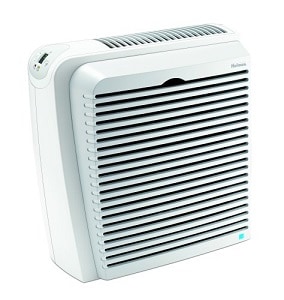If you are thinking about purchasing an air purifier for your home, then knowing about the different types of air purifiers can help to make your buying decision somewhat easier.
So here are the basic and most popular types of air purifiers for home use.
Table of Content
Types of Air Purifiers And How They Work!
Air Filters

In many cases these types of air purifiers are part of your cooling and or heating system and may even be placed in return air vents.
They work on a very simple principal of catching and trapping contaminants in the air. Filters can be made from foam, cotton, fiber glass, or synthetic material.
The best types of air filters for purifying the air are HEPA filters (High efficiency particle air) which must meet specific Department of energy standards.
HEPA filter air purifiers are said to remove 99.9% of contaminants from the air.
In order to work properly, Air filters need to be constantly cleaned and maintained.
Ionizing Purifiers
Another type of air purifier is the ionizing air purifiers.
These purifiers use a small, but intense electrical field to either produce a negative or positive charge.
These electrical charges attract pollutants of the opposite charge causing them to cling together and either fall from the air or attach themselves to plates inside the ionizer.
The problem with ionizing purifiers is, while they may remove contaminants from the air, these contaminants can end up on your furniture, floors, or even walls, which is less than helpful for asthma or allergy sufferers.
Ionizing purifies are usually extremely expensive, but many experts feel that Ionizing purifiers are not very efficient at cleaning the air.
Ozone Generators
Ozone generators are supposed to deodorizer and disinfect the air.
However, even extremely low levels of Ozone can cause respiratory problems as well as chest pain and inhibit a person’s ability to fight respiratory infections.
Ozone generators may actually end up doing more harm than good and are extremely expensive.
Adsorbents
Adsorbent air purifiers usually use some type of porous material such as charcoal to trap fumes, odors and large air contaminants, thus cleaning the air of these contaminants.
Like air filters Adsorbent air purifiers depend on circulating air to push air through the purifier where the adsorbent material can trap the contaminants.
Next to filters, adsorbent air purifiers probably are the most efficient at removing larger contaminants from the air.
UV Light Purifiers
UV light purifiers use ultra violet light to render certain micro organisms sterile and harmless.
These purifiers don’t actually remove contaminants, rather they keep certain contaminants (such as mold or mildew) from growing.
Keep in mind that while experts do agree that the right air purifier can help to reduce household contaminants, they work best when used in conjunction with other methods of removing contaminants.
Proper ventilation of the home, as well as frequent vacuuming, using green cleaning products and steam cleaning, all will help to reduce the amount of contaminants in your home so you and your family can breathe easier.
Air Purifiers to Consider
GermGuardian AC4825 22” UPGRADED 3-in-1 Full Room Air Purifier, True HEPA Filter LEVOIT LV-PUR131 Air Purifier with True HEPA Filter, Air Cleaner for Large Room, Allergies
LEVOIT LV-PUR131 Air Purifier with True HEPA Filter, Air Cleaner for Large Room, Allergies Honeywell True HEPA Allergen Remover, 465 sq. Ft, HPA300
Honeywell True HEPA Allergen Remover, 465 sq. Ft, HPA300


